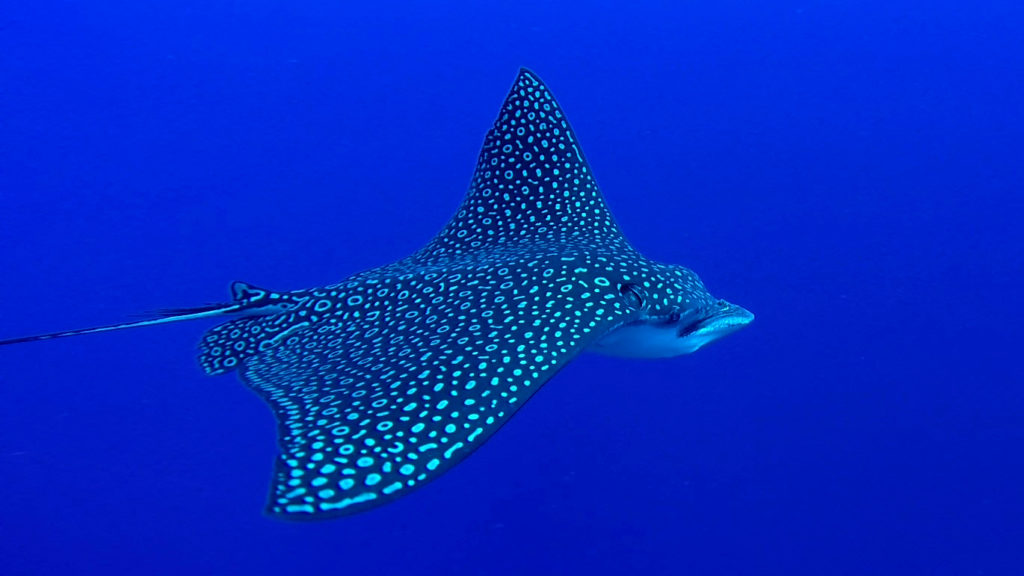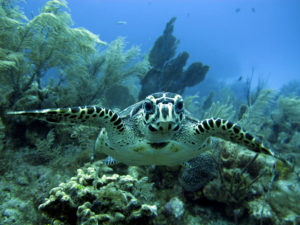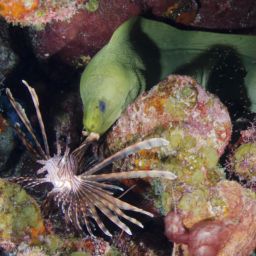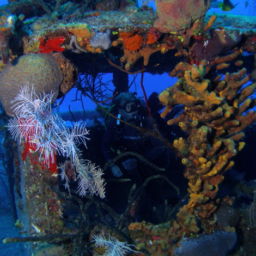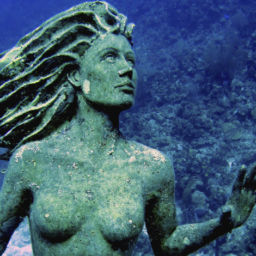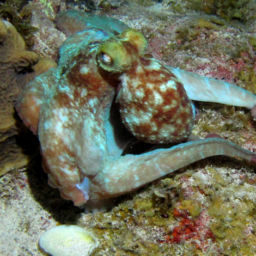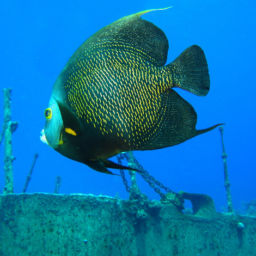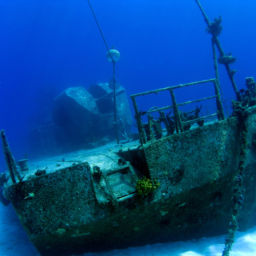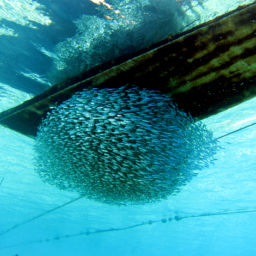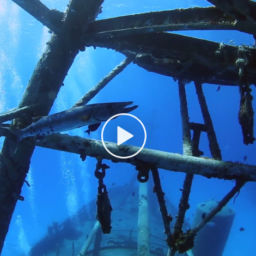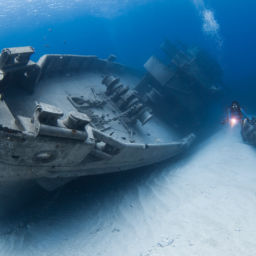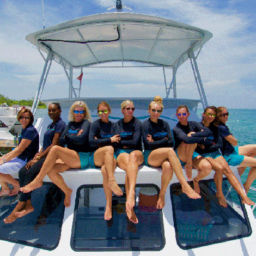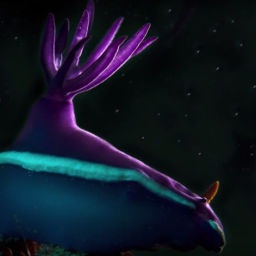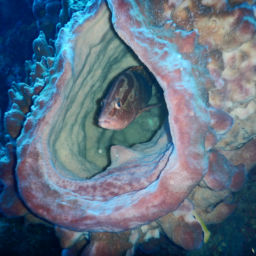A barrier reef surrounds Grand Cayman, dropping down into the Cayman Trough (also called the Trench), the Caribbean Sea’s deepest point. Because of this, you can splash in pretty much anywhere. And since Grand Cayman is flat and has no river run-off, visibility usually hovers between 80 and 120 feet (24 to 37 m). There are three main dive areas: the West, the North Wall and the East End of Grand Cayman. Most of the population and many of the hotels are on the west side of the island, clustered around the famous Seven Mile Beach. Lots of dive shops and operators frequent sites over here as well as the North Wall, a sheer drop-off that plummets far beyond the recreational-dive limit.
Only two operators, Ocean Frontiers and Tortuga Divers, visit the sites on the little-developed East End. Although it’s easy to drive over for a morning dive, it’s far more pleasant to stay in this quiet area of the island, where scenic stretches of rugged ironshore coastline hug turquoise seas. On most days, you can see the dark shadows of the coral fingers reaching out to the wall, rarely more than a quarter mile offshore. There are lots of great sites to choose from, but below we’ve highlighted seven of the best dive sites on the East End of Grand Cayman.
Jack McKenny’s Canyon
This site is at the top of my list each time I visit the East End because there’s a high likelihood of seeing Caribbean or blacktip reef sharks. Although there haven’t been shark-interaction dives in Grand Cayman since before 2002, sharks at this site have become more inquisitive because of spearfishing to eradicate the invasive lionfish. Even without the sharks this is a great dive, beginning at 50 feet (15 m), with several overhangs and swim-throughs. Aside from the sharks you’ll see the usual cast of Caribbean reef fish.
Dumbo’s Look out
You’ll probably see turtles in Cayman, and you’ve got a good chance of spotting rays as well. Sharks on the East End are likely, and there’s even a long-shot chance you’ll spot a hammerhead or manta ray. But at Dumbo’s Lookout, you’ll see something you probably won’t see anywhere else — a pygmy elephant. The story goes that a disgruntled divemaster stole his boss’s porcelain elephant plant pot, and dropped it off at this dive site. It now sits perched on a pinnacle in about 60 feet (18 m) of water. Swim around and between the pinnacles at this site as you peer over the wall into the depths below. Watch your gauges though, because it’s quite easy to lose perspective on this site where the depth drops dramatically down the wall.
Lodge Anchor
This is a shallow dive site in about 30 to 60 feet (10 to 18 m), so you’ll get plenty of bottom time and color for photos. There are swim-throughs galore here, with lobsters and crabs hiding in crevices and the occasional banded eel. A large anchor is reputed to be from the Wreck of the Ten Sail, a convoy of 10 merchant ships that ran into the reef in 1794. It’s long been rumored that Caymanians enjoy a tax-free status because they rescued a royal prince, the son of King George III, from the wreckage. In recompense, he granted the island immunity from war conscription and taxes. Although this fable is oft repeated, there’s no evidence that it’s true.
 Black Rock Canyon and wall
Black Rock Canyon and wall
With a prevailing wind blowing from the northeast, this corner of Grand Cayman sees fewer visitors than the south coast. Many divers have heard of the nearby dive site Babylon, which is well worth a visit. But don’t miss Black Rock Canyon and its wall, with a shallow reef in 30 feet (10 m) of water. Colorful schools of fish swirl everywhere, and a canyon reaches out to the wall, which drops into the blue with some impressive overhangs. If you see a turtle or an eagle ray below, keep an eye on your depth because the wall is deceiving.
 Three Sisters
Three Sisters
Three Sisters is named for the three towering pinnacles that provide the focal point for this dive. Spiraling around the pinnacles, watch for Caribbean lobster antennae poking from the holes and green moray and banded eels peering out inquisitively from crevices. Blackspotted pufferfish flit around coral heads; arrow crabs hide in tube sponges and coral crabs dwell beneath overhangs. Also keep an eye out for turtles nibbling on the reef.
Lost Wall
In an effort to preserve the reef, the Cayman Department of Environment installs mooring buoys so anchor drops are not necessary. This relatively pristine site was only recently rediscovered thanks to one of these new mooring buoys. Starting in around 50 feet (15 m), you’ll find plenty of canyons, crevices and caverns to swim through. This colorful site also boasts schools of snapper, triggerfish, scrawled filefish and the perhaps a few shy porcupinefish before finally plateauing onto the wall at around 100 feet (30 m).
Stingray City
Although not strictly an East End dive, you can easily explore Stingray City in the afternoon, after visiting the wall on a two-tank dive. This famous 15-foot dive (or snorkel) in crystal-clear water lets you get up close and personal with southern stingrays. For years, returning fishermen would stop here in the North Sound to gut their catch, attracting stingrays waiting for a free meal. Since the 1950s, enterprising boat captains have taken tourists out to visit the Stingray City sandbar, continuing to feed the rays and offering a unique experience that families can enjoy together.
Finally, although it’s not a specific dive site, it’s worth joining one of Ocean Frontier’s lionfish culls if you can. In order to maximize the lionfish haul, the boat visits uncharted dive sites, often un-dived places. As a happy side effect, you’ll be diving on untouched reefs as you hunt for lionfish.






